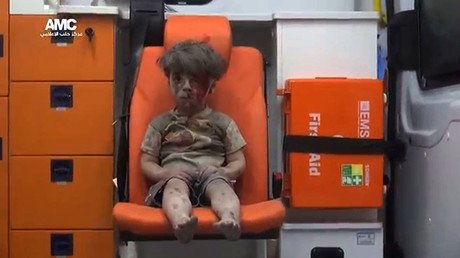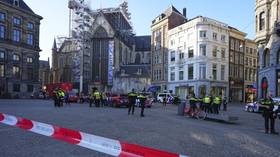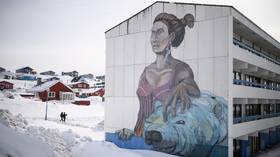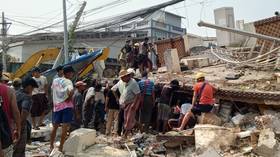Propaganda tool? China skeptical over images of Syrian boy as source denies ties with child-killers
China’s state broadcaster has questioned the media narrative surrounding the footage of a five-year-old Syrian boy shell-shocked after a bombing. The man who released the images may have ties with a rebel group notorious for beheading a teenager on camera.
Omran Daqneesh was reportedly saved from the rubble in the aftermath of a bombing in the rebel-held Qaterji district of Aleppo last Wednesday. A volunteer rescue group called the White Helmets, also known as the Syrian Civil Defense, released the footage of the dust and blood-covered child sitting in an ambulance chair.
The image quickly went viral, with the US State Department calling the child "the real face" of the Syrian war.
In a weekend report, Chinese state broadcaster CCTV suggested the video may have been partially staged and criticized the way it was used to stir pro-rebel sympathies.
"Critics have suggested that [the video] is part of a propaganda war, aimed at creating a 'humanitarian' excuse for Western countries to become involved in Syria," the voiceover to Saturday's report said, as cited by AFP. "The workers did not make rapid rescue efforts, and instead quickly set up a camera."
The report added that the White Helmets, which say they are a neutral party in the Syrian conflict, have close links to the British military.
The bombing, which was said to have injured four other children, was initially blamed on Russia. Moscow denied the allegations and accused the Western media of “cynical use of this tragedy in anti-Russian propaganda material.”
The Russian military said the damage shown in the footage published by world media outlets indicates a blast less powerful than that produced by an aerial bomb, considering that some of the glass in nearby buildings was not shattered. The military instead suggested that it may have been caused by a mortar shell or a gas cylinder IED.
READ MORE: Russia denies bombing Aleppo civilians as photo of bloodied 5yo boy goes viral
China’s skepticism over the media reports may be due to the identity of the author of the footage. Mahmoud Rslan has described himself as a war journalist and activist in interviews, but his online trail suggests he may have close ties to the Harakat Nour al-Din al-Zenki, an Islamist rebel group which made headlines in July after it published a video showing the beheading of a 12-year-old Palestinian boy.
The group, which was considered “moderate” enough to receive weapons from the US, claimed that the beheading was conducted arbitrarily by the commanders involved and pledged to investigate it. Previously the group was reported by Amnesty International as having conducted kidnappings and torture of journalists, aid workers and civilians in Aleppo.
Among the photos posted by Rslan was a selfie with several people, including two men who apparently participated in the beheading.
Same photographer(Mahmoud Rslan) shot photos of gang that beheaded 11yr boy( Abdallah Issa) & the photos of Omran pic.twitter.com/WMJO42G3EW
— Tony Man™ (@MrTonyMan) August 19, 2016
The photographer denied any ties with the child-killers, or that he even knew that they were fighters at the time he took the selfie.
“I strongly hope that you understand the complexities of living and working in a war zone and hope you don't let this one photo distract from the story of the daily massacres of the [Syrian President Bashar] Assad and Russian forces on civilians every day,” he said in a statement.
Just received this from @TheSyriaCmpgn - a statement from Mahmoud Rislan the photographer of #OmranDaqneeshpic.twitter.com/Dv2n2odsdJ
— Sophie McNeill (@Sophiemcneill) August 19, 2016
“The photographer is known on Facebook, on YouTube for continually posting images applauding the Zenki militia, who are a terrorist organization well known even before this horrendous beheading,” Sara Flounders, head of the International Action Centre, told RT. “He is not by any stretch of the imagination a human rights activist.”
Civilians, including children, have suffered from shelling and bombing conducted by all sides of the Syrian conflict. Victims of the rebels however tend to receive less coverage in the Western media than those of the Syrian Army, and are not designated “the face of the war” by the State Department.














